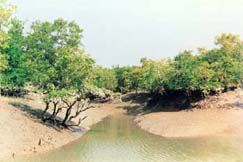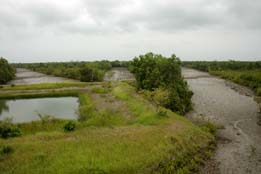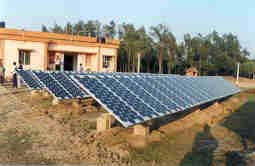|
|
 |
Objectives of Management |
 |
|
Strategies for Management |
 |
|
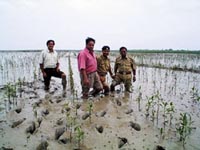

|
Constitution of Management Unit
The total area of this Biosphere Reserve has been divided into the following inter-related zones:
(1) The core zone is a compact block of R.F. covering approximately 1700 sq. km. lying in the eastern portion of Sundarban adjoining Bangladesh border and is bounded by Matla river in the west and butts into Bay of Bengal . This fully protected area containing the Sundarban National Park is devoted to conservation of bio-diversity, including primitive area which has remained free from any external disturbances since a long time. Nature in pristine glory exists here.
(2) Buffer zone comprises majority of mangrove areas including reserved forests areas adjoining area surrounding the above core zone and includes portion of the buffer zone of tiger reserve, Sajnakhali Wild Life Sanctuary and compact R.F. blocks lying between Matla and Thakuran under 24-Parganas (South) Forest Division.
(3) Transition zone : Covers the balance of the Biosphere Reserve area, which contains mangrove areas mostly in non-forest areas and reclaimed areas with agriculture.
|
Goals and Activities |
 |
A. Protection of Mangrove Ecosystem
Intensification of surveillance-
The northern and western fringes of Indian Sundarban are heavily populated and lack of agricultural production and job opportunities haunt the remote villages. It result into intense biotic pressure on the forest from the fishermen, wood collectors, honey collectors and poachers. The organized timber and wildlife mafia exploit the poverty of the villagers. Therefore, the immediate need for conservation of the Mangrove Eco-system is to strengthen the organizational infrastructure of the Forest Department. Since in the estuarine forest, the only means of communication is watercrafts - a few watercrafts, including speed boats, have been supplied to facilitate faster movement of the patrolling staff posted in remote camps. Land-based camps and check posts have been established to ensure round the clock vigil on the transit routes. Radio Telephone sets are also supplied to bring all the offices and camps under a unified RT Network. Improved firearms like 0.315 Rifles have been supplied to field staff as replacement of conventional and out-dated DBBL guns. Mobile Phones and Satellite Phones are provided to the senior officers to facilitate communication and organizing raids against the mafia in the city.
|

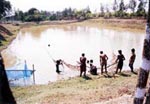
Top |
B. Habitat Improvement
AFFORESTATION / SOIL CONSERVATION
1.
(i) Afforestation with Mangrove spp : There are large strips of newly created mudflats and char lands as well as nearly 3500 km of embankments, which have been afforested with the following objectives:
a) Stabilisation of the mudflats
b) Restoration of mangrove eco-system
c) Stabilisation of the embankments
d) Conservation of the threatened species
(ii) Afforestation with fast-growing and indigenous species : The slopes and base of the embankments, away from the tidal action, have been planted up with indigenous and quick growing species to meet the local demand of fuel/fodder and small timber.
2.
Land Development and improvement of soil-moisture :
Some of the islands within the mangrove forest do not experience regular inundation by tidal action, due to turtle-back shape at the center of the islands. This results into increase of salinity and formation of saline blanks which do not support any vegetation. It is proposed to dig canals across some of these areas, on experimental basis, to facilitate tidal flooding and increased moisture in such barren areas. Artificial and natural introduction of mangrove seeds may improve the vegetation cover.
3.
Distribution of seedlings for planting on private lands.
4.
Habitat Development Activities:
(i) Development of water holes for catering the need of sweet water to the wild animals.
(ii) Opening up canopy through construction of observation lines, which also help the growth of herbivores. Top
|
C.Reduction of Man-Animal conflict
Straying of tigers from the Reserved Forests into the habitations along the Northern and Western fringes of Sundarban Forest occasionally result into death of cattle/human beings as well as tiger. Illegal entry of fishermen into core areas as well as entry of honey-collectors into the forest also leads to killing of a no. of people by the tigers. . An ex-gratia relief of Rs 30,000/- is paid for human casualty.
In order to prevent straying of tiger into villages, Nylon net as well as Goran chita fencing are being erected along the forest-village interface. Tranquilisation and capture of the straying animal and their subsequent release into the forest, is also frequently resorted to. Making the fringe villagers aware about the need for conservation of tiger through the FPC/EDCs has been extremely effective. Training of the staff in use of tranquilizer gun, use of capture cage/net, quick response at the time of straying and generating support of the villagers are part of capacity building initiatives to tackle tiger straying. These efforts, coupled with Eco-development activities are paying dividend . Between 1994-95 and 2001-02, there had been 25 recorded cases of tiger straying, leading to death of 10 tigers whereas during 2002-03 to 2005-06, there were 20 cases of tiger straying with only one tiger getting killed, that too for self-defense.
|


|
D. Eco-Development and JFM support activities
No governmental efforts to conserve and create assets/ resources can be successful and sustainable unless the people concerned actively participate in planning and management of the resources. Participatory or Joint Mangrove Management (JMM) is thus the basis of sustainable Conservation of Mangrove Eco-system. On the basis of the experiences of peoples' participation in forest management in Southern West Bengal, W.B. Forest Department has issued Govt. Orders facilitating the formation of Forest Protection Committees (FPC) around the Reserved/ Protected Forests, and Eco-Development Committees (EDC) around the National Park and Sanctuaries of Sundarban region also. Till now, 52 FPCs and 14 EDCs have been registered in Sundarban.
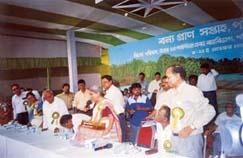 |
Members of the FPCs and EDCs participate in protection of the forests against exploitations. However, since large population in the fringe villages are intensively dependent on the resources of the mangrove eco-system, closure of the resource against exploitation will lead to further unemployment and starvation of the people below poverty line (BPL). Such actions are bound to alienate the landless families and people below poverty line, and will go against the concept of conservation. Therefore, our effort is to create "alternate livelihood options" for these target groups and dilute the biotic pressure on the ecologically fragile mangrove ecosystem. Whatever meager development funds are made available for the forest fringe villages, these are utilized for creating resources through the process of Micro-level Planning and participatory implementation.
Socio-economic and natural resource survey of the region shows that sweet water for irrigation and drinking purpose is a highly scarce commodity. Due to shortage of sweet water, agriculture in the region is highly under-developed and productivity is very low. Mere provision of fresh, sweet water can bring revolution in the agricultural practices and generate tremendous employment and resources. Since the region is blessed with moderately high and well-distributed rainfall, conservation of the rainwater through impounding in canals and ponds receives the topmost priority in the resource generation sector. Availability of irrigation water during dry months can convert the mono-cropped areas into multi-cropped ones. Therefore, construction of irrigation canals and ponds constitute important components of Eco-development activities.
The sweet water ponds and canals can also be simultaneously used for fresh water aqua-culture to generate additional income for the beneficiaries selected from the BPL categories, landless families and marginal farmers.
Vocational training and input in cottage industries, apiculture, mushroom cultivation, floriculture etc can strive to make the forest-dependent people more self-sufficient. Efforts have been made to encourage the poorer section of the people to form Self-Help Groups (SHG) to avail of bank loans to start their own ventures/trades.
The FPC/EDC members are being encouraged to create Community Fund, through their contributions from the benefits derived out of JFM support services, which will help to sustain the development activities in the villages even after the withdrawal of the Fund from various schemes.
Top
|
F. Confidence-building activities
Building up of trust between the foresters and forest fringe dwellers form the key to success of JFM/ JMM. Activities like construction of village brick paths greatly facilitate communication and help better marketing of agricultural and other produces.
Similarly, construction of pucca jetties, installation of Solar lights, Janata Insurance coverage of the FPC/EDC members and organizing regular medical camps in remote locations where medical help is not readily available, help in creation of goodwill and makes the people more responsive towards protection of the mangrove eco-system.
|
Various JFM Support activities and Eco-Development activities that are being implemented, are as follows :
|
(A) Community Development Projects : |
|
(B) Individual beneficiaries oriented schemes |
- Construction of irrigation canals for rain-water harvesting.
- Construction of sweet water ponds for irrigation as well as fresh water pisciculture.
- Construction of village brick paths to improve communication.
- Construction of jetties.
- Digging of tube-wells for drinking water supply.
- Supply of solar lights.
- Organising regular medical camps in remote areas.
- Construction of embankments for protection of villages.
|
|
- Apiary, mushroom cultivation.
- Piggery, Goat rearing, Duckery, Poultry.
- Vocational training for Cottage industries like boutique printing etc
- Development of Self Help Groups.
- Training and input for vocations/ professions like tailoring, cycle repairing etc.
Top |
|
|
|
















